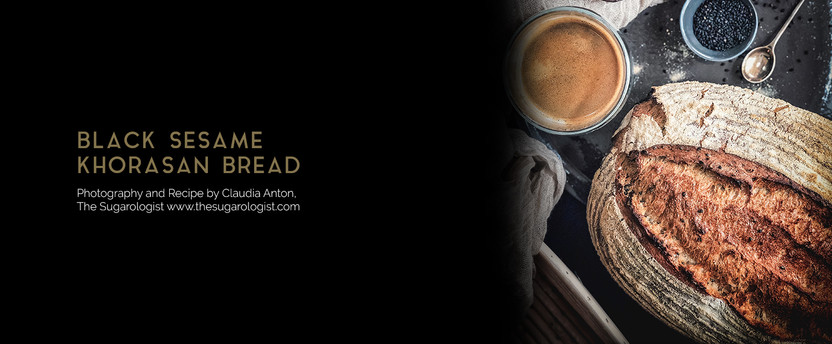Black Sesame Khorasan Bread
8th Jan 2021
Photography and Recipe by Claudia Anton, The Sugarologist www.thesugarologist.com
Ingredients
For the pre-ferment:
- 200g organic white bread flour
- 50g organic Khorasan flour (Kamut)
- 4g yeast (scant 1 tsp) – I use Saf brand or Dr Oetker
- 175ml warm water (28 degrees Celsius)
For the dough:
- 175g organic white bread flour
- 75g organic Khorasan flour
- 1 tsp malted barley flour
- 4g yeast
- 1 quantity pre-ferment (prepared above)
- 200ml warm water (28 degrees Celsius)
- 20g sesame seeds – black toasted
- 7g Salt
To season the proving basket:
- 100g rice flour
- 100g white bread making flour (extra can be made and stored for future bakes)
Instructions
Start the bread the day before you plan to bake it.
Make the preferment first:
This will help to improve the flavour and texture of the final bread as well as speed up the proving process on the day of baking.
- In a large mixing bowl, mix together the flours and yeast using a whisk to combine well.
- Make a well in the middle and pour in the water.
- Mix by hand at first using a spatula to moisten the flour.
- Either knead the dough by hand on a floured bench for about 8 minutes or mix on medium using a dough hook in a stand mixer for six minutes until the dough is smooth and elastic.
- Prove the dough for one hour at room temperature.
- Move it into a large oiled bowl and refrigerate, covered overnight. (up to 24 hours)
- The next day, take the dough out one hour before you plan to bake and sit at room temperature.
- Toast the sesame seeds in a heavy-based frypan over medium heat until they are just starting to become fragrant. Allow them to cool in a bowl.
For the dough:
- Using a large mixing bowl, mix together the dry ingredients except for the seeds with a whisk.
- Add the pre-ferment along with the water and use a spatula to gently moisten everything.
- Using a dough hook and a stand mixer, knead the dough for 8 minutes until smooth and elastic, and a piece of dough passes the windowpane test. (ie it can be stretched until thin and transparent without breaking). You are after a soft, moist but cohesive dough. Knead the sesame seeds in at the end until they are well distributed.
- Prove the dough for one to two hours in a warm place or until doubled in size.
- Gently empty the dough onto a lightly floured bench. Shape the dough into a batard, (or a round if using a round basket) making sure that what will be the top of the bread is tight and smooth. (Chad Robertson in his book, Tartine bread give some excellent shaping instructions which I have found very easy to follow – plus his sourdough recipe is amazing)
- Mix together the rice and bread flour until combined.
- Dust a proving basket liberally with a mixture of rice flour and bread flour.
- If the shaped bread is a little sticky, I like to roll it in gently in the dusting flour before placing it, top side down, in the proving basket.
- Place the bread, covered in a damp towel, in a warm place to prove.
- Preheat the oven to 240 degrees Celsius, fan forced. Place one tray at the top of the oven, and one in the lower third of the oven.
- Place a sided baking pan on the top tray, and a baking stone or heavy baking tray on the lower rung. I have a slide in baking trays in my oven which I use upside down to bake my bread, and which works well to get a brown bottom.
- The bread will be ready to bake when it has started to visibly rise but not yet doubled. This way it has some rising to do and will be less fragile on transfer.
- Place a piece of baking paper on a tray. ( to make a peel)
- Turn bread gently onto the tray. Quickly make a slash down the middle (or whatever pattern you choose), using a bakers Lame (razor), or a very sharp knife. Dipping the blade in water first may help stop it sticking. Slide the bread quickly, directly onto the hot baking stone or tray.
- Pour a cup of water into the tray on the top tray in the oven.
- Toss an extra half a cup of water in the bottom of the oven twice in the first few minutes of baking.
- Bake at 240 degrees for five minutes before turning down the oven and baking for another 20-25 minutes until golden.
- Remove the bread and cool on a rack.

